Most of all - Sony Xperia Z Ultra review
Sony's giant, the Xpera Z Ultra, has probably attracted a bit more attention than other models this year. The format that is still not very familiar to our latitudes already has its supporters and opponents. In this review, we will look at the new product in more detail and try to figure out why smartphones are good (they are also shades). Forward!
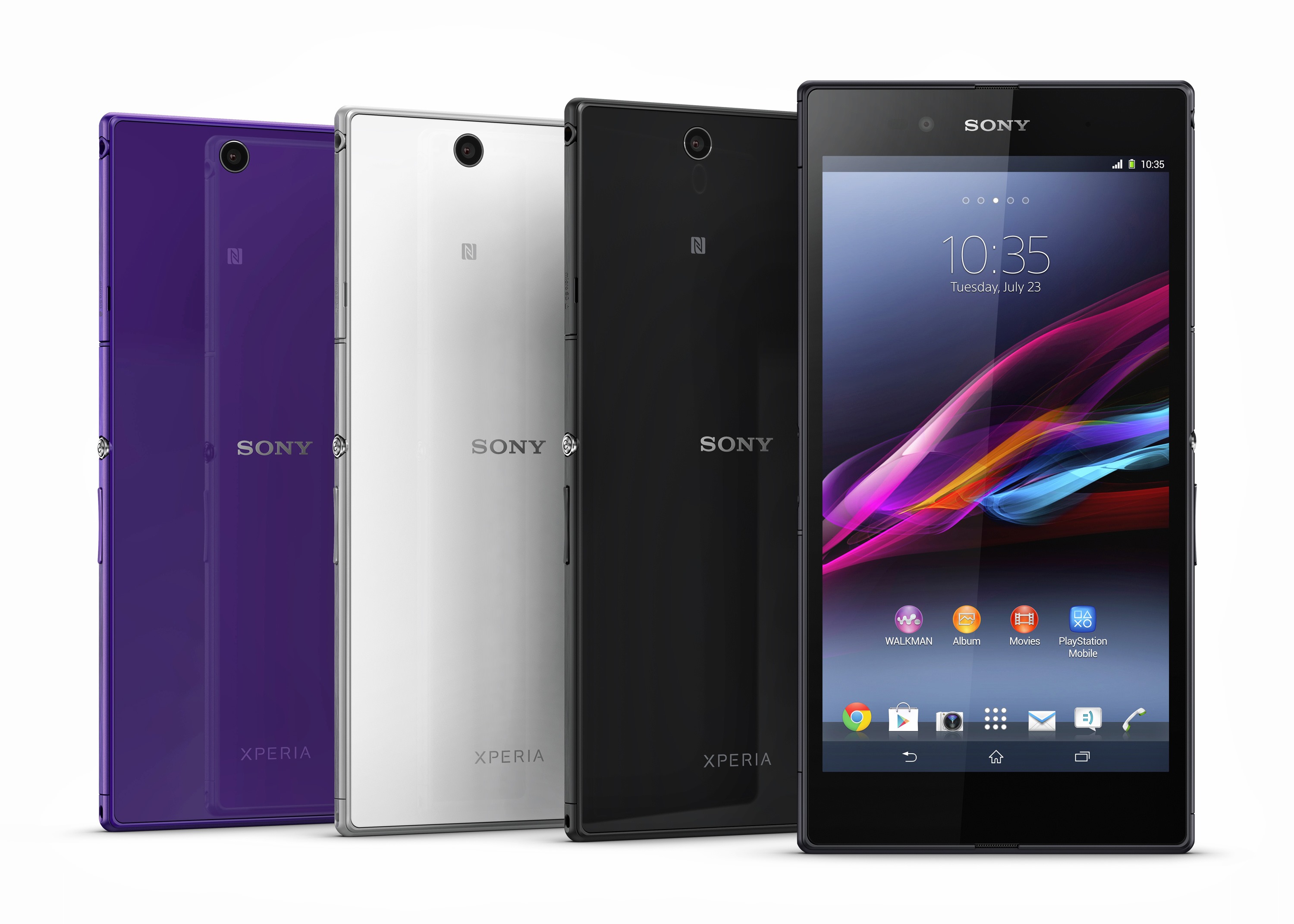
Design and ergonomics
In a long white box is a telephone, a high-capacity charger, a USB cable and a docking station with a magnetic connector. The latter, by the way, has the cable “tightly” attached, but on the reverse side there is a regular plug that can be connected to both charging and a computer (though if the USB port is not powerful enough, the device will charge quite slowly).

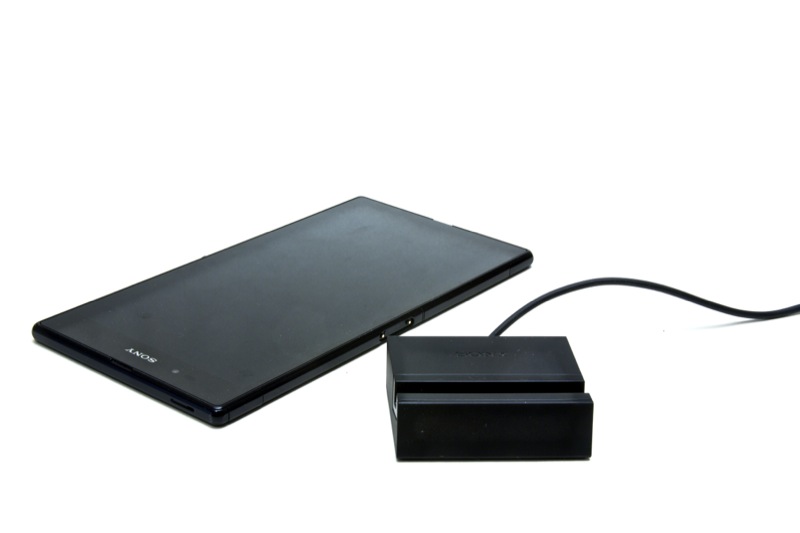
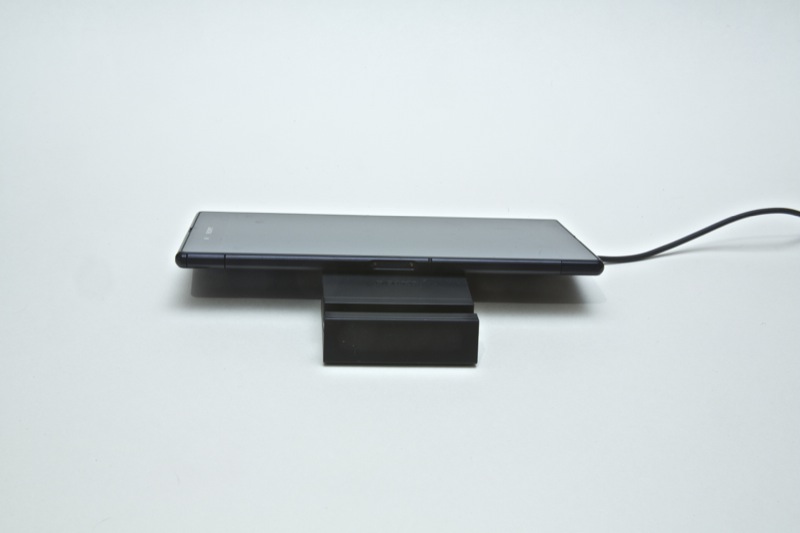
The device, of course, impresses with its size, but it is very thin and quite light. The design is inherited from Z and Z1 - strict straight lines, slightly rounded corners, a minimum of noticeable details. The slot for SD and Micro SIM-cards is located on the right side and is covered with one plug, under it is a round metal power button, traditional for the design concept of this year, and an invisible volume control. If you hold the phone in your right hand - they are under the thumb. At the very top is the headset jack, which we are used to seeing at the top end. The left side carries a USB / HDMI connector, also covered by a plug, and a magnetic connector for charging through the dock. In the latter, by the way, the phone is installed horizontally, which is very convenient for watching videos or working with an external keyboard. In the lower right corner there is an opening for a strap or some trinket. The back panel is made of glass and covered with a protective film, the camera lens is located in its upper part, but almost the entire “facade” occupies a huge screen. Quite noticeable fields are left above and below, for the bottom, by the way, it’s convenient to hold the phone while reading.
Speaking “in a traditional way”, that is, putting the phone in your ear, is surprisingly convenient, although it looks a bit strange from the outside. The speaker is loud, and the microphone is sensitive (plus there are various software enhancements such as noise reduction, compression and even speech retardation). On the other hand, of course, it is more convenient to carry the device in a bag or jacket pocket and use a wireless headset (for example, Sony SBH52) to control calls and music.
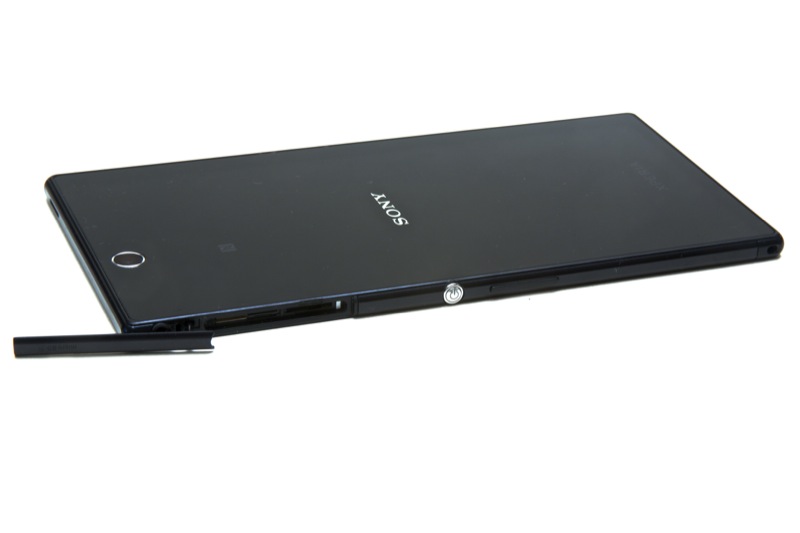
Here we have a very decent 6.4-inch TRILUMINOS display with an IPS matrix, a resolution of 1920x1080, X-Reality technology, an excellent margin of brightness and good viewing angles. The pixel density, of course, is lower than that of Z (342 instead of 441) but with the naked eye it is still not noticeable. When tilted more than 45 degrees, the picture loses a little in colors, but does not lose brightness, however, I can’t imagine a person who needs to carefully consider something from such an angle. Reading on the Z Ultra is a complete pleasure, with both text documents and e-books, and PDF files. The same can be said of films. It is very convenient to use the on-screen keyboard - even in vertical mode, you can type with two thumbs and not miss. By the way, Z Ultra also supports handwriting with capacitive styluses, a simple pencil or any other thin object with electrical conductivity. In the same way, you can make various sketches, for which there is even a special application called “Sketch”. The screen, of course, does not recognize the strength and angle of pressing, and it is far from graphic tablets, but it is quite possible to draw some kind of neat scheme.
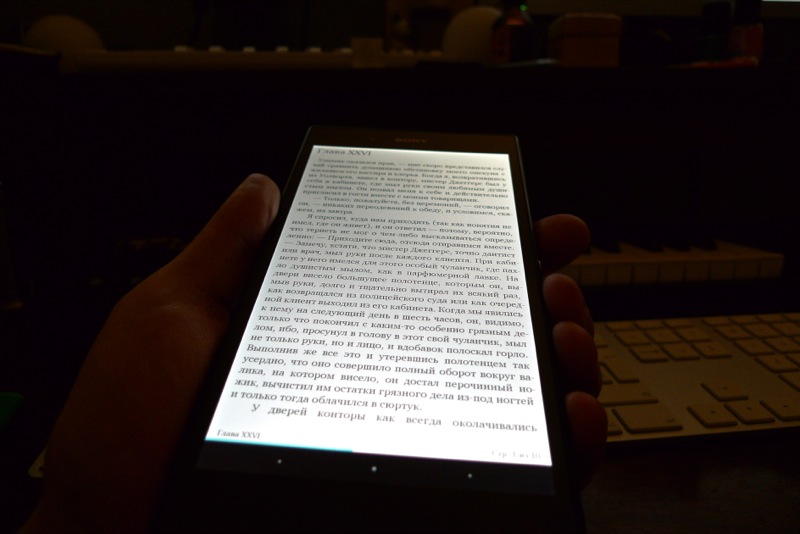

The enlarged diagonal allows you to place many icons and widgets on one desktop. On a blank screen fits 36 icons (and 6 more - in the dock). On-screen buttons, which many do not like, now take up very little space, and besides, they still hide when starting full-screen applications or watching videos. The only problem, perhaps, is that not all applications are adapted for large screens and some of their elements look somewhat blurry, so look for HD versions in the market, if any.
Devices of this format are not very suitable for frequent photography, so the camera here is the most common. Good old eight-megapixel Exmor RS is still in business and provides quite decent image quality under any conditions. The automatic mode, however, should be used only in good light - in twilight and darkness, he likes to lift the ISO to the maximum, which generates very annoying noises. It’s better to switch to manual mode and leave the ISO at 400. There are
traditionally many settings: exposure adjustment, white balance, metering and focus mode, HDR, smile detection, startup on the server, panorama shooting, real-time filters, etc. Video is recorded in FullHD with the ability to take one megapixel pictures in the process.
As for the front camera, the Z Ultra has a two-megapixel camera, with a stabilizer and a softening effect, which makes it possible to slightly reduce the amount of noise, like the classmates. In general - an ordinary frontal camera, well coping with its task.
Unlike other models, there is no LED flash and a hardware button for shooting (but the settings from it remain - a flaw!). The lack of a button is not particularly annoying, but a flash would be useful, for example, for shooting documents (on the other hand, there will be slightly less terrible photos like “flash in the forehead” in the world).

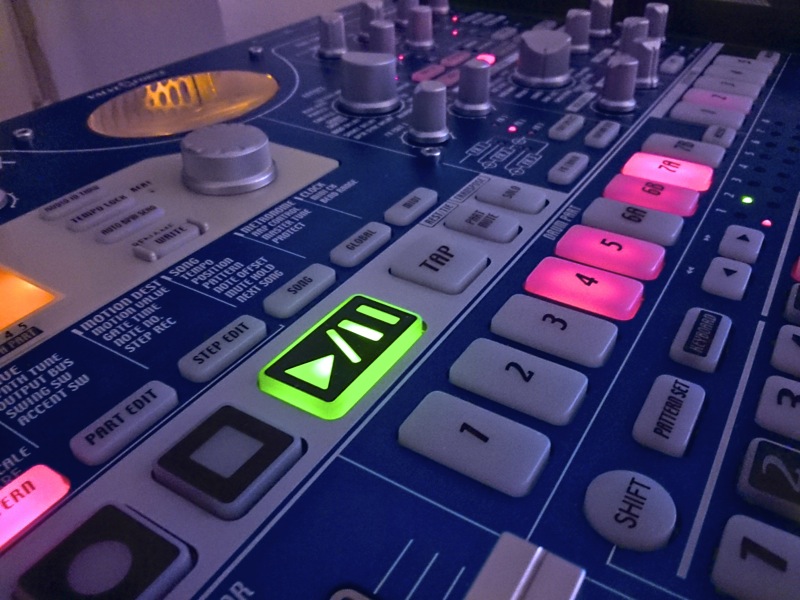







Capacity 3000 mAh, in principle, is not so much for such a large device, and even with a FullHD-screen, but for the whole day it is perfectly enough. Even if you drive your smartphone in the tail and in the mane - watch videos on Youtube, read, play, chat, listen to music, actively use 3G and geolocation and, at the same time, do not turn on the STAMINA mode - about 20% of the charge remains by the end of the day. At rest, overnight, it completely discharges two percent. To save money, you can use various energy consumption schemes, for example, automatically turn on WiFi only in certain places. If you activate “Stamina” when fully charged, the corresponding indicator promises that the phone will work for 18 days at rest. I am inclined to believe this statement.
The quad-core Snapdragon 800 processor is responsible for the performance (by the way, the Xperia Z Ultra is one of the first phones on the market equipped with this processor) and the Adreno 330 video accelerator. Despite the large screen, there are plenty of hardware resources for absolutely any tasks and ways to make the Z Ultra I did not find a little brake, although I tried. You can watch the test results below.

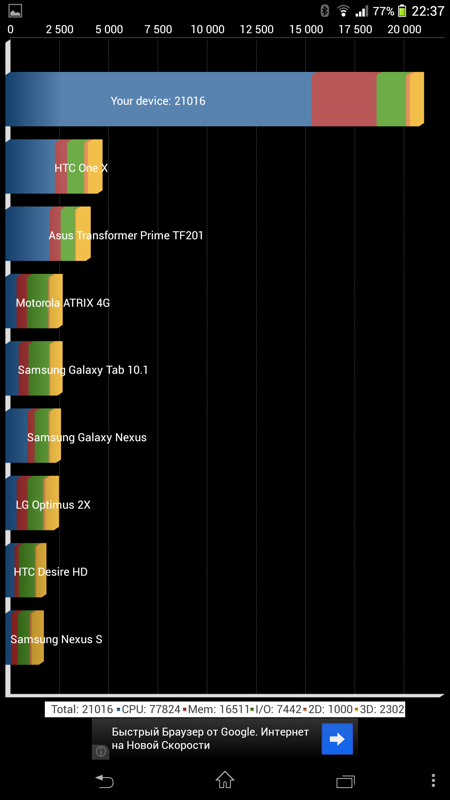


During the week of use, there were no problems - the connection was not disconnected, the network was not lost, the Internet worked perfectly, the location was determined ideally throughout the entire ten-kilometer test route.
Like all new Sony models, the Z Ultra is running Android 4.2.2 with the ability to quickly upgrade to 4.3 (we already wrote habrahabr.ru/company/sonyxperia/blog/190896 on how to work on this update), as well as a proprietary shell. The set of pre-installed applications includes Evernote, Socialife, Office Suite, McAfee Security, FIle Commander, NeoReader, in general - a set of software that is already familiar to everyone, which can be used, or can be deleted unselected. We already mentioned the most pleasant feature from the latest shell update - a customizable quick settings panel, available, along with a list of notifications, on the lock screen. There is also a huge number of pre-installed widgets and gadgets that can be constantly visible on the screen, for example, to quickly create notes.
Traditionally high-quality, as befits Sony devices, sound with juicy bass, a clear middle and clean tops. The built-in Walkman player is beyond praise, it regularly indexes music downloaded to a flash drive, neatly sorts it by artist and album, knows how to create playlists, add individual rivers to favorites, assign them additional tags according to mood (SensMe section), download tags and covers from the Internet and give out music via WiFi. The settings are the same as on other devices - an equalizer, a compressor, a volume equalizer for tracks, a stereo expander, as well as mono-compatibility and volume up modes for an external speaker. You can control the player using the widget on the lock screen or, which is much more convenient, using the headset.
Despite its sleek appearance, the Z Ultra is protected by the same standards as its hardcore fellow ZR. IP58 guarantees water resistance at a depth of 1 meter and protection against dust (as well as the performance of the device in case the dust does get inside). Of course, you need to monitor the plugs, but none of them need to be opened often - the SIM and flash drive are installed, as a rule, once, and charging is still more convenient through the dock. Protecting the audio jack does not require any plugs at all. But underwater shooting can be difficult due to the lack of a camera start button, although I don’t know who would have thought of diving with such a large device.
Despite the mixed reaction from the public, such a device format is really in demand, primarily among business people who do not want to carry a smartphone and tablet at the same time and need to quickly work with documents and conduct extensive correspondence. Complete with a wireless headset and an external keyboard (and without them, if necessary), it successfully replaces several devices at once, and weighs and takes up space, while not more than a large notebook. At the same time, Z Ultra is perfect for those who prefer a mobile device for information and entertainment, as It perfectly shows itself as a device for reading, surfing the web, watching videos and games.
Processor: quad-core Qualcomm Snapdragon 800 MSM8974, 2200 MHz
Memory: 2 GB of RAM, 16 GB of internal memory, support for SD cards (up to 64 GB)
Video: Adreno 330
Display: 6.4 ”, TRILUMINOS, 1920x1080, 16 million colors, scratch protection.
Navigation: GPS, GLONASS
Main camera: Exmor RS 8 megapixels
Front camera: 2 megapixels
Battery: 3000 mAh, non-removable
OS: Android 4.2
Protection: IP58
Dimensions: 179 x 92 x 6.5 mm
Weight: 212 g

Design and ergonomics
In a long white box is a telephone, a high-capacity charger, a USB cable and a docking station with a magnetic connector. The latter, by the way, has the cable “tightly” attached, but on the reverse side there is a regular plug that can be connected to both charging and a computer (though if the USB port is not powerful enough, the device will charge quite slowly).


The device, of course, impresses with its size, but it is very thin and quite light. The design is inherited from Z and Z1 - strict straight lines, slightly rounded corners, a minimum of noticeable details. The slot for SD and Micro SIM-cards is located on the right side and is covered with one plug, under it is a round metal power button, traditional for the design concept of this year, and an invisible volume control. If you hold the phone in your right hand - they are under the thumb. At the very top is the headset jack, which we are used to seeing at the top end. The left side carries a USB / HDMI connector, also covered by a plug, and a magnetic connector for charging through the dock. In the latter, by the way, the phone is installed horizontally, which is very convenient for watching videos or working with an external keyboard. In the lower right corner there is an opening for a strap or some trinket. The back panel is made of glass and covered with a protective film, the camera lens is located in its upper part, but almost the entire “facade” occupies a huge screen. Quite noticeable fields are left above and below, for the bottom, by the way, it’s convenient to hold the phone while reading.
Speaking “in a traditional way”, that is, putting the phone in your ear, is surprisingly convenient, although it looks a bit strange from the outside. The speaker is loud, and the microphone is sensitive (plus there are various software enhancements such as noise reduction, compression and even speech retardation). On the other hand, of course, it is more convenient to carry the device in a bag or jacket pocket and use a wireless headset (for example, Sony SBH52) to control calls and music.

Screen
Here we have a very decent 6.4-inch TRILUMINOS display with an IPS matrix, a resolution of 1920x1080, X-Reality technology, an excellent margin of brightness and good viewing angles. The pixel density, of course, is lower than that of Z (342 instead of 441) but with the naked eye it is still not noticeable. When tilted more than 45 degrees, the picture loses a little in colors, but does not lose brightness, however, I can’t imagine a person who needs to carefully consider something from such an angle. Reading on the Z Ultra is a complete pleasure, with both text documents and e-books, and PDF files. The same can be said of films. It is very convenient to use the on-screen keyboard - even in vertical mode, you can type with two thumbs and not miss. By the way, Z Ultra also supports handwriting with capacitive styluses, a simple pencil or any other thin object with electrical conductivity. In the same way, you can make various sketches, for which there is even a special application called “Sketch”. The screen, of course, does not recognize the strength and angle of pressing, and it is far from graphic tablets, but it is quite possible to draw some kind of neat scheme.


The enlarged diagonal allows you to place many icons and widgets on one desktop. On a blank screen fits 36 icons (and 6 more - in the dock). On-screen buttons, which many do not like, now take up very little space, and besides, they still hide when starting full-screen applications or watching videos. The only problem, perhaps, is that not all applications are adapted for large screens and some of their elements look somewhat blurry, so look for HD versions in the market, if any.
Camera
Devices of this format are not very suitable for frequent photography, so the camera here is the most common. Good old eight-megapixel Exmor RS is still in business and provides quite decent image quality under any conditions. The automatic mode, however, should be used only in good light - in twilight and darkness, he likes to lift the ISO to the maximum, which generates very annoying noises. It’s better to switch to manual mode and leave the ISO at 400. There are
traditionally many settings: exposure adjustment, white balance, metering and focus mode, HDR, smile detection, startup on the server, panorama shooting, real-time filters, etc. Video is recorded in FullHD with the ability to take one megapixel pictures in the process.
As for the front camera, the Z Ultra has a two-megapixel camera, with a stabilizer and a softening effect, which makes it possible to slightly reduce the amount of noise, like the classmates. In general - an ordinary frontal camera, well coping with its task.
Unlike other models, there is no LED flash and a hardware button for shooting (but the settings from it remain - a flaw!). The lack of a button is not particularly annoying, but a flash would be useful, for example, for shooting documents (on the other hand, there will be slightly less terrible photos like “flash in the forehead” in the world).









Battery
Capacity 3000 mAh, in principle, is not so much for such a large device, and even with a FullHD-screen, but for the whole day it is perfectly enough. Even if you drive your smartphone in the tail and in the mane - watch videos on Youtube, read, play, chat, listen to music, actively use 3G and geolocation and, at the same time, do not turn on the STAMINA mode - about 20% of the charge remains by the end of the day. At rest, overnight, it completely discharges two percent. To save money, you can use various energy consumption schemes, for example, automatically turn on WiFi only in certain places. If you activate “Stamina” when fully charged, the corresponding indicator promises that the phone will work for 18 days at rest. I am inclined to believe this statement.
Performance
The quad-core Snapdragon 800 processor is responsible for the performance (by the way, the Xperia Z Ultra is one of the first phones on the market equipped with this processor) and the Adreno 330 video accelerator. Despite the large screen, there are plenty of hardware resources for absolutely any tasks and ways to make the Z Ultra I did not find a little brake, although I tried. You can watch the test results below.




Communication
During the week of use, there were no problems - the connection was not disconnected, the network was not lost, the Internet worked perfectly, the location was determined ideally throughout the entire ten-kilometer test route.
Software
Like all new Sony models, the Z Ultra is running Android 4.2.2 with the ability to quickly upgrade to 4.3 (we already wrote habrahabr.ru/company/sonyxperia/blog/190896 on how to work on this update), as well as a proprietary shell. The set of pre-installed applications includes Evernote, Socialife, Office Suite, McAfee Security, FIle Commander, NeoReader, in general - a set of software that is already familiar to everyone, which can be used, or can be deleted unselected. We already mentioned the most pleasant feature from the latest shell update - a customizable quick settings panel, available, along with a list of notifications, on the lock screen. There is also a huge number of pre-installed widgets and gadgets that can be constantly visible on the screen, for example, to quickly create notes.
Multimedia
Traditionally high-quality, as befits Sony devices, sound with juicy bass, a clear middle and clean tops. The built-in Walkman player is beyond praise, it regularly indexes music downloaded to a flash drive, neatly sorts it by artist and album, knows how to create playlists, add individual rivers to favorites, assign them additional tags according to mood (SensMe section), download tags and covers from the Internet and give out music via WiFi. The settings are the same as on other devices - an equalizer, a compressor, a volume equalizer for tracks, a stereo expander, as well as mono-compatibility and volume up modes for an external speaker. You can control the player using the widget on the lock screen or, which is much more convenient, using the headset.
Protection
Despite its sleek appearance, the Z Ultra is protected by the same standards as its hardcore fellow ZR. IP58 guarantees water resistance at a depth of 1 meter and protection against dust (as well as the performance of the device in case the dust does get inside). Of course, you need to monitor the plugs, but none of them need to be opened often - the SIM and flash drive are installed, as a rule, once, and charging is still more convenient through the dock. Protecting the audio jack does not require any plugs at all. But underwater shooting can be difficult due to the lack of a camera start button, although I don’t know who would have thought of diving with such a large device.
Summary
Despite the mixed reaction from the public, such a device format is really in demand, primarily among business people who do not want to carry a smartphone and tablet at the same time and need to quickly work with documents and conduct extensive correspondence. Complete with a wireless headset and an external keyboard (and without them, if necessary), it successfully replaces several devices at once, and weighs and takes up space, while not more than a large notebook. At the same time, Z Ultra is perfect for those who prefer a mobile device for information and entertainment, as It perfectly shows itself as a device for reading, surfing the web, watching videos and games.
Specifications
Processor: quad-core Qualcomm Snapdragon 800 MSM8974, 2200 MHz
Memory: 2 GB of RAM, 16 GB of internal memory, support for SD cards (up to 64 GB)
Video: Adreno 330
Display: 6.4 ”, TRILUMINOS, 1920x1080, 16 million colors, scratch protection.
Navigation: GPS, GLONASS
Main camera: Exmor RS 8 megapixels
Front camera: 2 megapixels
Battery: 3000 mAh, non-removable
OS: Android 4.2
Protection: IP58
Dimensions: 179 x 92 x 6.5 mm
Weight: 212 g
